Sergei Yesenin
Sergei Alexandrovich Yesenin (/jəˈseɪnɪn/;[2] sometimes spelled as Esenin; Russian: Серге́й Алекса́ндрович Есе́нин, IPA: [sʲɪrˈgʲej ɐlʲɪkˈsandrəvʲɪtɕ jɪˈsʲenʲɪn]; 3 October [O.S. 21 September] 1895 – 28 December 1925) was a Russian lyric poet. He is one of the most popular and well-known Russian poets of the 20th century.[3]
Sergei Yesenin | |
|---|---|
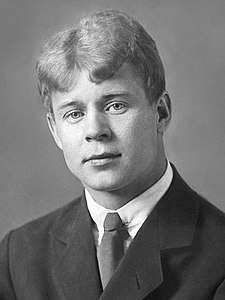 | |
| Born | Sergei Alexandrovich Yesenin 3 October 1895[1] |
| Died | 28 December 1925 (aged 30)[1] |
| Resting place | Vagankovo Cemetery, Moscow |
| Nationality | Russian |
| Occupation | Lyrical poet |
| Movement | Imaginism |
| Spouse(s) | Anna Izryadnova (1913–1916) Zinaida Reich (1917–1921) Isadora Duncan (1922–1925) Sophia Tolstaya (1925; his death) |
Biography
Early life
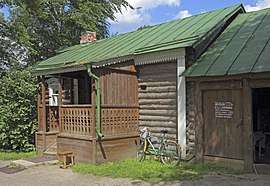
Sergei Yesenin was born in Konstantinovo in Ryazan Governorate of the Russian Empire to a peasant family. His father was Alexander Nikitich Yesenin (1873–1931), his mother Tatyana Fyodorovna (nee Titova, 1875–1955).[4]
Both his parents spent most of their time looking for work, father in Moscow, mother in Ryazan, so at age two Sergei was moved to the nearby village Matovo, to join Fyodor Alexeyevich and Natalya Yevtikhiyevna Titovs, his relatively well-off maternal grandparents, who essentially raised him.[5]
The Titovs had three grown-up sons, and it was they who were Yesenin's early years' companions. "My uncles taught me horse-riding and swimming, one of them... even employed me as hound-dog, when going out to the ponds hunting ducks," he later remembered. He started to read aged five, and at nine began to write poetry, inspired originally by chastushkas and folklore,[6] provided mostly by the grandmother whom he also remembered as a highly religious woman who used to take him to every single monastery she’d choose to visit.[7] He had two younger sisters, Yekaterina (1905–1977), and Alexandra (1911–1981).[4]
In 1904 Yesenin joined the Konstantinovo zemstvo school. In 1909 he graduated it with an honorary certificate, and went on to study in the local secondary parochial school in Spas-Klepiki. From 1910 onwards, he started to write poetry systematically; eight poems dated that year were later included in his 1925 Collected Works.[4] In all, Yesenin wrote around thirty poems during his school years. He compiled them into what was supposed to be his first book which he titled "Bolnye Dumy" (Sick Thoughts) and tried to publish it in 1912 in Ryazan, but failed.[8]
In 1912, with a teacher’s diploma, Yesenin moved to Moscow, where he supported himself working as a proofreader's assistant at the Sytin's printing company. The following year he enrolled in Chanyavsky University to study history and philology as an external student, but had to leave it after eighteen months due to lack of funds.[7] In the University he became friends with several aspiring poets, among them Dmitry Semyonovsky, Vasily Nasedkin, Nikolai Kolokolov and Ivan Filipchenko.[5] Yesenin’s first marriage (which lasted three years) was in 1913 to Anna Izryadnova, a co-worker from the publishing house, with whom he had a son, Yuri.[9] 1913 saw Yesenin becoming increasingly interested in Christianity, biblical motives became frequent in his poems. "Grisha, what I am reading at the moment is the Gospel and find a lot of things which for me are new,"[10] he wrote to his close childhood friend G. Panfilov. That was also the year when he became involved with the Moscow revolutionary circles: for several months his flat was under secret police surveillance and in September 1913 it was raided and searched.[8]
Life and career
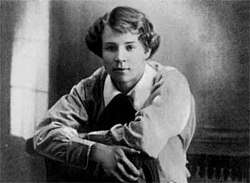
In January 1914 Yesenin's first published poem "Beryoza" (The Birch Tree) appeared in the children's magazine Mirok (Small World). More appearances followed in minor magazines such as Protalinka and Mlechny Put. In December 1914 Yesenin quit work "and gave himself to poetry, writing continually," according to his wife.[11] Around this time he became a member of the Surikov Literary and Music circle.[4]
In 1915, exasperated with the lack of interest in his work in Moscow, Yesenin moved to Petrograd. He arrived at the city on 8 March and the next day met Alexander Blok at his home, to read him poetry. He received a warm welcome and soon became acquainted with fellow-poets Sergey Gorodetsky, Nikolai Klyuev and Andrei Bely and well known in literary circles. Blok was especially helpful in promoting Yesenin's early literary career, describing him as "a gem of a peasant poet"[12] and his verse as "fresh, pure and resounding", even if "wordy".[13] The same year he joined the Krasa (Beauty) group of peasant poets which included Klyuyev, Gorodetsky, Sergey Klychkov and Alexander Shiryayevets, among others.[8] In his 1925 autobiography Yesenin said that Bely gave him the meaning of form while Blok and Klyuev taught him lyricism.[14] It was Klyuyev who introduced Yesenin to the publisher Averyanov, who in early 1916 released his debut poetry collection Radunitsa which featured many of his early spiritual-themed verse. "I would have eagerly relinquished some of my religious poems, large and small, but they make sense as an illustration of poets' progress towards the revolution," he would later write.[8] Yesenin and Klyuyev maintained close and intimate[15] friendship which lasted several years.[6][16]
In 1915 Yesenin became a co-founder of the Krasa literary group and published numerous poems in the Petrograd magazines Russkaya Mysl, Ezhemesyachny Zhurnal, Novy Zhurnal Dlya Vsekh, Golos Zhizni and Niva.[7] Among the authors he met later in the year were Maxim Gorky, Vladimir Mayakovsky, Nikolai Gumilyov and Anna Akhmatova; he also visited painter Ilya Repin in his Penaty.[9] Yesenin's rise to fame was meteoric; by the end of the year he became the star of St Petersburg's literary circles and salons. "The city took to him with the delight a gourmet reserves for strawberries in winter. A barrage of praise hit him, excessive and often insincere," Maxim Gorky wrote to Romain Rolland.[17]
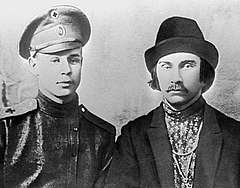
On 25 March 1916, Yesenin was drafted for military duty and in April joined a medical train based in Tsarskoye Selo, under the command of colonel D.N. Loman. In 22 July 1916, at a special concert attended by the Empress Alexandra Fyodorovna (the train's patron) and her daughters, Yesenin recited his poems "Rus" and "In Scarlet Fireglow".[6] "The Empress told me my poems were beautiful, but sad. I replied, the same could be said about Russia as a whole," he recalled later.[7] His relationships with Loman soon deteriorated. In October, Yesenin declined the colonel's offer to write (with Klyuyev) and have published a book of pro-monarchist verses, and spent twenty days under arrest as a consequence.[9]
In March 1917, Yesenin was sent to the Warrant Officers School but soon deserted the Kerensky's army.[9] In August 1917 (having divorced Izryadnova a year earlier) Yesenin married for a second time, to Zinaida Raikh (later an actress and the wife of Vsevolod Meyerhold). They had two children, a daughter Tatyana and a son Konstantin.[4] The parents subsequently quarreled and lived separately for some time prior to their divorce in 1921. Tatyana became a writer and journalist and Konstantin Yesenin would become a well-known soccer statistician.
Yesenin supported the February Revolution. "If not for [it], I might have withered away on useless religious symbolism," he wrote later.[8] He greeted the rise of the Bolsheviks too. "In the Revolution I was all on the side of the October, even if perceiving everything in my own peculiar way, from a peasant's standpoint," he remembered in his 1925 autobiography.[8] Later he criticized the Bolshevik rule, in such poems as "The Stern October Has Deceived Me". "I feel very sad now, for we are going through such a period in [our] history when human individuality is being destroyed, and the approaching socialism is totally different from the one I was dreaming of," he wrote in an August 1920 letter to his friend Yevgeniya Livshits.[18] "I never joined the RKP, being further to the left than them," he maintained in his 1922 autobiography.[6]
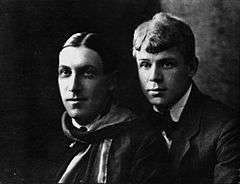
Artistically, the revolutionary years were exciting time for Yesenin. Among the important poems he wrote in 1917–1918 were "Prishestviye" (The Advent), "Peobrazheniye" (Transformation, which gave the title to the 1918 collection), and "Inoniya". In February 1918, after the Sovnarkom issued the "Socialist Homeland is in Danger!" decree-appeal, he joined the esers' military unit. He actively participated in the magazine Nash Put (Our Way), as well as the almanacs Skify (Скифы) and Krasny Zvon (in February his large poem "Marfa Posadnitsa" appeared in one of the latter).[4] In September 1918 Yesenin co-founded (with Andrey Bely, Pyotr Oreshin, Lev Povitsky and Sergey Klychkov) the publishing house Трудовая Артель Художников Слова (the Labor Artel of the Artists of the Word) which reissued (in six books) all that he'd written by this time.[19][9]
In September 1918, Yesenin became friends with Anatoly Marienhof, with whom he founded the Russian literary movement of imaginism. Describing their group's general appeal, he wrote in 1922: "Prostitutes and bandits are our fans. With them, we are pals. Bolsheviks do not like us due to some kind of misunderstanding."[6] In January 1919, Yesenin signed the Imaginists' Manifest. In February he, Marienhof and Vadim Shershenevich, founded the Imaginists publishing house. Before that, Yesenin became a member of the Moscow Union of Professional Writers and several months later was elected a member of the All-Russian Union of Poets. Two of his books, Kobyliyu Korabli (Mare's Ships) and Klyuchi Marii (The Keys of Mary) came out later that year.[9]
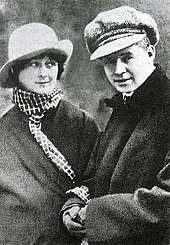
In July–August 1920, Yesenin toured the Russian South, starting in Rostov-on-Don and ending in Tiflis, Georgia. In November 1920, he met Galina Benislavskaya, his future secretary and close friend. Following an anonymous report, he and two of his Imaginist friends, brothers Alexander and Ruben Kusikovs, were arrested by the Cheka in October but released a week later on the solicitation of his friend Yakov Blumkin.[9] In the course of that year, the publication of three of Yesenin's books were refused by publishing house Goslitizdat. His Triptych collection came out through the Skify Publishers in Berlin. Next year saw the collections Confessions of a Hooligan (January) and Treryaditsa (February) published. The drama in verse Pygachov came out in December 1921, to much acclaim.[4]
In May 1921 he visited a friend, the poet Alexander Shiryaevets, in Tashkent, giving poetry readings and making a short trip to Samarkand. In the fall of 1921, while visiting the studio of painter Georgi Yakulov, Yesenin met the Paris-based American dancer Isadora Duncan, a woman 18 years his senior. She knew only a dozen words in Russian, and he spoke no foreign languages. Nevertheless, they married on 2 May 1922. Yesenin accompanied his celebrity wife on a tour of Europe and the United States. His marriage to Duncan was brief and in May 1923, he returned to Moscow.[4] In his 1922 autobiography, Yesenin wrote: "Russia's recent nomadic past does not appeal to me, and I am all for civilization. But I dislike America intensely. America is a stinking place where not just art is being murdered, but with it, all the loftiest aspirations of humankind. If it's America that we are looking up to, as [a model for our] future, then I'd rather stay under our greyish skies... We do not have those skyscrapers that's managed to produce up to date nothing but Rockefeller and McCormick, but here Tolstoy, Dostoyevsky, Pushkin and Lermontov were born."[7]
In 1923 Yesenin became romantically involved with the actress Augusta Miklashevskaya to whom he dedicated several poems, among them those of the Hooligan's Love cycle. In the same year, he had a son by the poet Nadezhda Volpina. Alexander Esenin-Volpin grew up to become a poet and a prominent activist in the Soviet dissident movement of the 1960s. Since 1972, till his death in 2016, he lived in the United States as a famous mathematician and teacher.
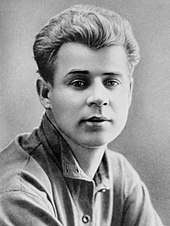
As Yesenin's popularity grew, stories began to circulate about his heavy drinking and consequent public outbursts. In autumn 1923, he was arrested in Moscow twice and underwent a series of enquiries from the OGPU secret police. Fellow poet Vladimir Mayakovsky, wrote that, after his return from America, Yesenin became more visible in newspaper police log sections than in poetry.[20]
More serious were the accusations of anti-Semitism against Yesenin and three of his close friends, fellow poets, Sergey Klytchkov, Alexei Ganin and Pyotr Oreshin, made by Lev Sosnovsky, a prominent journalist and close Trotsky associate. The foursome retorted with an open letter in Pravda and, in December, were cleared by the Writers' Union burlaw court. It was later suggested, though, that Yesenin's departure to the Caucasus in the summer of 1924 might have been a direct result of the harassment by the NKVD. Earlier that year, fourteen writers and poets, including his friend Ganin, were arrested as the alleged members of the (apparently fictitious) Order of the Russian Fascists, then tortured and executed in March without trial.[4]
In January–April 1924, Yesenin was arrested and interrogated four times. In February, he entered the Sheremetev hospital, then was moved into the Kremlin clinic in March. Nevertheless, he continued to make public recitals and released several books in the course of the year, including Moskva Kabatskaya. In August 1924 Yesenin and fellow poet Ivan Gruzinov published a letter in Pravda, announcing the end of the Imaginists.[9]
In early 1925 Yesenin met and married Sophia Andreyevna Tolstaya (1900–1957), a granddaughter of Leo Tolstoy. In May what proved to be his final large poem Anna Snegina came out. During the year, he compiled and edited The Works by Yesenin in three volumes which was published by Gosizdat posthumously.[9]
Death
On 28 December 1925, Yesenin was found dead in his room in the Hotel Angleterre in St Petersburg. His last poem Goodbye my friend, goodbye (До свиданья, друг мой, до свиданья) according to Wolf Ehrlich was written by him the day before he died. Yesenin complained that there was no ink in the room, and he was forced to write with his blood.
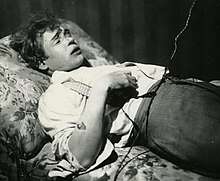
До свиданья, друг мой, до свиданья. |
Farewell, my good friend, farewell. |
According to his biographers, the poet was in a state of depression and committed suicide by hanging.[21]
After the funeral in the Union in Leningrad, poet Yesenin's body was transported by train to Moscow, where a farewell for relatives and friends of the deceased was also arranged. He was buried 31 December 1925, in Moscow's Vagankovskoye Cemetery. His grave is marked by a white marble sculpture.
A theory exists that Yesenin's death was actually a murder by OGPU agents who staged it to look like suicide. The novel Yesenin[22] published by Vitali Bezrukov is devoted to this version of Yesenin's death. In 2005 TV serial Sergey Yesenin based on this novel (with Sergey Bezrukov playing Yesenin) was shown on Channel One Russia.[23] Facts tending to support the assassination hypothesis were cited by Stanislav Kunyaev and Sergey Kunyaev in the final chapter of their biography of Yesenin.[24]
Enraged by his death, Mayakovsky composed a poem called To Sergei Yesenin, where the resigned ending of Yesenin's death poem is countered by these verses: "in this life it is not hard to die, / to mold life is more difficult." In a later lecture on Yesenin, he said that the revolution demanded "that we glorify life." However, Mayakovsky himself would commit suicide in 1930.[25]
Cultural impact
Yesenin's suicide triggered an epidemic of copycat suicides by his mostly female fans. For example, Galina Benislavskaya, his ex-girlfriend, killed herself by his graveside in December 1926. Although he was one of Russia's most popular poets and had been given an elaborate state funeral, some of his writings were banned by the Kremlin during the reigns of Joseph Stalin and Nikita Khrushchev. Nikolai Bukharin's criticism of Yesenin contributed significantly to the banning. Only in 1966 were most of his works republished. Today Yesenin's poems are taught to Russian schoolchildren; many have been set to music and recorded as popular songs. His early death, coupled with unsympathetic views by some of the literary elite, adoration by ordinary people, and sensational behavior, all contributed to the enduring and near mythical popular image of the Russian poet.
Bernd Alois Zimmermann included his poetry in his Requiem für einen jungen Dichter (Requiem for a Young Poet), completed in 1969.
The Ryazan State University is named in his honor.[26]
In popular culture
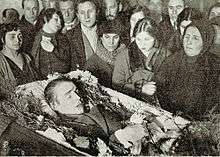
Yesenin appears as a character in the 1981 ballet Isadora, by Kenneth Macmillan.
A monument to Yesenin opened in St. Petersburg in 1995.
In 2005 Russian studio Pro-Cinema Production produced a TV mini-series Yesenin. The movie described the version of his death according to which he was murdered by NKVD agents who staged his suicide. In the mini-series Yesenin was portrayed by Sergey Bezrukov.
Sergei Yesenin's final poem was a major inspiration for the Bring Me the Horizon song "It Was Written in Blood" on their album Suicide Season.
Yesenin is used as a pseudonym for a fictional poet in The Book of Laughter and Forgetting by Milan Kundera
Jim Harrison's poetry collection Letters to Yesenin is a series of poems addressed to Yesenin that illuminate his life and death.
Multilanguage editions
Anna Snegina (Yesenin's poem translated into 12 languages; translated into English by Peter Tempest) ISBN 978-5-7380-0336-3
Works
- The Scarlet of the Dawn (1910)
- The high waters have licked (1910)
- The Birch Tree (1913)
- Autumn (1914)
- Russia (1914)
- I'll glance in the field (1917)
- I left the native home (1918)
- Hooligan (1919)
- Hooligan's Confession (1920) (Italian translation sung by Angelo Branduardi)
- I am the last poet of the village (1920)
- Prayer for the First Forty Days of the Dead (1920)
- I don't pity, don't call, don't cry (1921)
- Pugachev (1921)
- Land of Scoundrels (1923)
- One joy I have left (1923)
- A Letter to Mother (1924)
- Tavern Moscow (1924)
- Confessions of a Hooligan (1924),
- A Letter to a Woman (1924),
- Desolate and Pale Moonlight (1925)
- The Black Man (1925)
- To Kachalov's Dog (1925)
- Goodbye, my friend, goodbye (1925) (His farewell poem)
References
- Sergey Aleksandrovich Yesenin. Encyclopaedia Britannica
- "Yesenin." Random House Webster's Unabridged Dictionary.
- Merriam-Webster, Inc (1995). Merriam-Webster's Encyclopedia of Literature. Merriam-Webster. pp. 1223–. ISBN 978-0-87779-042-6. Retrieved 28 October 2012.
- S.A. Yesenin. Life and Work Chronology Archived 18 September 2016 at the Wayback Machine. Хронологическая канва жизни и творчества Сергея Александровича Есенина (1895–1925) // Есенин С. А. Полное собрание сочинений: В 7 т. – Moscow. Nauka, 1995–2002.
- 1924 autobiography Archived 17 November 2016 at the Wayback Machine. The Works by Sergey Yesenin in Three Volumes. Moscow: Pravda Publishers. Vol. III, p 183// Сергей Есенин. Собрание сочинений в трех томах. Библиотека "Огонек". Moscow: Pravda Publishers. 1970
- 1922 Autobiography Archived 17 November 2016 at the Wayback Machine The Works by Sergey Yesenin in Three Volumes. Moscow. Pravda Publishers. Vol. III, pp 177-179// Сергей Есенин. Собрание сочинений в трех томах. Библиотека "Огонек". Издательство "Правда". Москва, 1970
- 1925 Autobiography Archived 17 November 2016 at the Wayback Machine. The Works by Sergey Yesenin in Three Volumes. Moscow. Pravda Publishers, vol. III, pp. 180–182 // Сергей Есенин. Собрание сочинений в трех томах. Библиотека "Огонек". Издательство "Правда". Москва, 1970
- Zakharov, A.I. Sergey Yesenin's biography at the Russian Writes Biobibliographical dictionary, 1990 // А. И. Захаров. "Русские писатели". Биобиблиографический словарь. Том 1. А-Л. Под редакцией П. А. Николаева. М., "Просвещение", 1990
- Sergey Yesenin Timeline. – www.e-reading.club // Основные даты жизни и творчества С. А. Есенина
- Гриша, в настоящее время я читаю Евангелие и нахожу очень много для меня нового
- Anna Izryadnova's Memoirs, 1965 // Изряднова А. Р. // Воспоминания о Сергее Есенине.-- М., 1965.-- С. 101
- Alexander Blok. Notebooks // Блок А. Записные книжки. 1901–1920. М., 1965. С. 567
- Alexander Blok. Collected Works in 8 Volumes. Vol.8, p. 441 // Блок А. Собр. соч.: В 8 т. – М.; Л., 1963. – Т. 8. – С. 441
- 1925 Autobiography Archived 17 November 2016 at the Wayback Machine. The Works by Sergey Yesenin in Three Volumes. Moscow. Pravda Publishers, vol. III, pp. 187–189 // Сергей Есенин. Собрание сочинений в трех томах. Библиотека "Огонек". Издательство "Правда". Москва, 1970
- Между Лениным и Есениным at Izvestia.ru
- Prokhushev, Yuri Sergey Yesenin. Biography. Detskaya Literatura, 1971 // Юрий Прокушев. Сергей Есенин. Москва, "Детская литература", 1971
- The Collected Works by Maxim Gorky in 30 volumes. Vol. 29, p. 459 // Собр. соч.: В 30 т. – М., 1955.- Т. 29. С. 459
- The Works by Sergey Yesenin in Three Volumes. Moscow. Pravda Publishers. Vol. III, p.242
- Лев Повицкий, друг Сергея Есенина / Lev Povitsky, the Friend of Sergey Yesenin. – www.esenin.ru / Memoirs
- V. Mayakovsky "How to Make Poems"
- Royzman, M.D (1973). "26. Есенин в санаторном отделении клиники. Его побег из санатория. Доктор А. Я. Аронсон. Диагноз болезни Есенина. Его отъезд в Ленинград". Сергей Есенин Всё, что помню о Есенине (in Russian). Moscow: Sovetskaya Rossiya.
- Bezrukov, Vitali (2005). Есенин. Moscow: Amfora. ISBN 5-94278-924-X.
- Romanova, Natalia. "Сергей Есенин. Убийство Есенина – убийство совести русского народа коммунистическим режимом". The Epoch Times.
- Kunyaev, Stanislav; Kunyaev, Sergey (2010). Сергей Есенин. Moscow: Molodaya gvardiya. ISBN 978-5-235-03363-4. (pp. 537-598). Among facts to support the assassination hypothesis were: 1) At the time of his death, Yesenin was actively working on his collected works. He was not drinking after his departure from Moscow and was enthusiastic about leaving the capital and working on other new texts. A project he was dreaming about was close to success: to start editing a literature magazine of his own. Most of his manuscripts were missing from his hotel room and had never been discovered (including his recently announced novella known under the work title When I was a boy… and his winter poems from the last months). Yesenin preferred to be well ordered in his work; but his hotel room was in extreme chaos, with his things scattered on the floor and with signs of a fight. 2) Yesenin had a fresh wound on his shoulder, one on his forehead and a bruise under one of his eyes. A few weeks before his death, many of his friends claimed that he had been carrying a revolver, but this weapon was never discovered. His jacket was missing, and he had to be covered with a sheet from the hotel. The ligature with which he purportedly hanged himself, made from a belt that later disappeared, was reportedly not a hanging one: it was only holding the body to one side, to the right. Nevertheless, no further investigations were documented to have been made in this direction. The room where he died was also not examined. 3) The photos of the hotel room and the body were not made by a police photographer. None of his close friends (e.g. Klyuev, Valerian Pravduhin, Ilya Sadofiev) was taken to see the room. Neither were they officially interrogated, while Ehrlich reportedly did not seem aggrieved by the events (Ehrlich was sentenced to death and shot in 1937). The work known as his last poem is sometimes considered as written in 1924 and dedicated to the fellow poet Viktor Manuilov. 4) The medical documentation does not include the supposed hour of death. Later experts considered it careless and point out that the language is uncharacteristic for an experienced doctor like the one involved, Alexander Gilyarevsky, who died in 1931. 5) The fact that Yesenin remained in the Hotel Angleterre, where there was a regular strong police presence, is still unexplained, given the poet’s late negativism towards the authorities and his persistent feeling that they were following him and threatening him, shared with friends on various occasions. Moreover, he was not registered in the hotel, as well as his friend, the writer Georgy Ustinov, which may be interpreted as a sign that the visit may have already been prepared and planned by others. (Georgy Ustinov also reportedly killed himself in 1932.)
- Mayakovsky, Vladimir (1975). Klop, Stikhi, Poėmy. Indiana University Press. pp. 28 (introduction by Patricia Blake). ISBN 0253201896.
- "Кратко об университете". Ryazan State University. Retrieved 8 September 2009. Cite journal requires
|journal=(help)
External links
| Wikimedia Commons has media related to Sergei Yesenin. |
Collection of Sergey Yesenin's Poems in English:
- Sergey Yesenin. Collection of Poems
- Sergey Yesenin. Collection of Poems. Bilingual Version
- The Fugue Aesthetics of J.H. Stotts: Esenin, Footnotes for a Triptych at blogspot.com (Bio and English translation)
- Sergey Yesenin's Autobiography. (English translation)
- Biography, photos and poetry (Russian)
- Yesenin's poetry (Russian)
- Yesenin's museum in Viazma (Russian)
- Alexander Novikov sings songs based on Yesenin's poetry (10 songs in WMA format
- Translation of "The Birch" by Leo Yankevich
- Translation of "The Orphan" by Akbar Muhammad
- The Dark Man (English translation)
- Farewell My Friend (English translation)
- The Poems by Sergey Esenin (English)
- Works by or about Sergei Yesenin at Internet Archive
- Works by Sergei Yesenin at LibriVox (public domain audiobooks)
